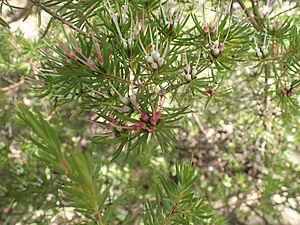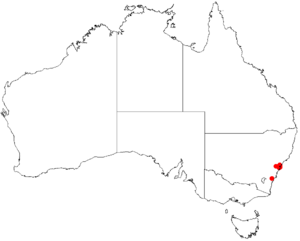Darwinia procera facts for kids
Quick facts for kids Darwinia procera |
|
|---|---|
 |
|
| Darwinia procera in the ANBG | |
| Scientific classification | |
| Genus: |
Darwinia
|
| Species: |
procera
|
 |
|
| Occurrence data from AVH | |
Darwinia procera is a special plant from the myrtle family. It is a type of shrub or bush that only grows in a small area of New South Wales, Australia. This means it is endemic to that region.
This plant has unique leaves that are thicker than they are wide. Its flowers are a pretty reddish-purple color. They grow in groups of four near the ends of the branches. Even though it's rare in nature, many people who love native plants enjoy growing Darwinia procera in their gardens.
Contents
What Does Darwinia Procera Look Like?
Darwinia procera is an upright bush that can grow up to about 3 meters (10 feet) tall. It has branches that stand straight up. The leaves are arranged in a special way, with pairs of leaves crossing each other along the stems.
These leaves are about 1 to 2.5 centimeters (0.4 to 1 inch) long. They are smooth and have a slightly bluish color. The leaves curve upwards and come to a sharp point.
Darwinia Procera Flowers
The flowers of Darwinia procera grow in small groups of about four. These groups are found at the very ends of the branches. Each flower sits on a tiny stalk, only 1 to 2 millimeters long.
The flower groups are surrounded by reddish leaf-like parts called bracts. These bracts are about 4 to 13 millimeters long. The main part of the flower, called the floral cup, is 5 to 8 millimeters long. It is about 2 millimeters wide. The petals form a white tube that covers the inner parts of the flower. A long, white part called the style sticks out from the flower tube. It is about 1.4 to 2 centimeters long. This plant usually flowers from late winter to early summer.
Where Does Darwinia Procera Grow?
This special darwinia plant grows in forests and scrubland. You can find it near the tops of sandstone valleys. These areas are located on the central coast just north of Sydney.
Is Darwinia Procera Protected?
Darwinia procera is a rare plant, but it is not currently in danger of disappearing. A large group of these plants is protected inside the Brisbane Water National Park. This helps make sure they can continue to grow safely in their natural home.
Growing Darwinia Procera in Gardens
Darwinia procera is quite popular among people who enjoy growing native Australian plants. Its unusual leaves are a big reason why. You can grow this plant from seeds, but it's often easier to start new plants from small pieces of the stem, called cuttings.
This plant is quite tough and can grow well in sandy soil that drains water easily. It prefers a spot that gets some shade. During long dry periods, it's a good idea to water it occasionally to help it thrive.

